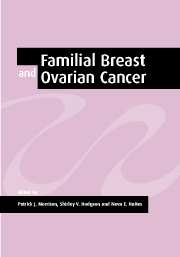Book contents
- Frontmatter
- Contents
- List of contributors
- Foreword by Helena Kennedy
- Preface
- Acknowledgements
- Part 1 Molecular biology and natural history
- Part 2 Screening
- Part 3 Management
- 15 Management of BRCA1/2 mutation carriers
- 16 Management of familial ovarian cancer
- 17 Prophylactic mastectomy in mutation carriers
- 18 Psychosocial aspects of genetic counselling for breast and ovarian cancer
- 19 BRCA1/2 testing: uptake and its measurement
- 20 Breast cancer genetics: ethical, social and insurance issues
- 21 Gene therapy for breast and ovarian cancer
- 22 Future directions
- Index
17 - Prophylactic mastectomy in mutation carriers
Published online by Cambridge University Press: 24 August 2009
- Frontmatter
- Contents
- List of contributors
- Foreword by Helena Kennedy
- Preface
- Acknowledgements
- Part 1 Molecular biology and natural history
- Part 2 Screening
- Part 3 Management
- 15 Management of BRCA1/2 mutation carriers
- 16 Management of familial ovarian cancer
- 17 Prophylactic mastectomy in mutation carriers
- 18 Psychosocial aspects of genetic counselling for breast and ovarian cancer
- 19 BRCA1/2 testing: uptake and its measurement
- 20 Breast cancer genetics: ethical, social and insurance issues
- 21 Gene therapy for breast and ovarian cancer
- 22 Future directions
- Index
Summary
Introduction
Management options available for women at high lifetime risk of breast cancer due to their family history, or carriage of a mutation in BRCA1/2 (which confer a lifetime risk of breast cancer of 85% (Ford et al., 1994; Wooster et al., 1994) are limited. Screening with mammography or even magnetic resonance imaging (MRI) is one option, and this can be combined with entering trials of chemo-prevention. However, many women are now seriously considering or undertaking prophylactic mastectomy if found to be mutation carriers for BRCA1 or BRCA2. The efficacy of surgical procedures to reduce the risk of breast cancer is controversial (Goodnight et al., 1984; Zeigler and Kroll, 1991), although it would appear that the residual risk of breast cancer is dependent upon the amount of remaining breast tissue following the surgical procedure. Recent work suggests that more women than previously are considering prophylactic mastectomy (JW et al., 1996; Lynch et al., 1997) and that protocols should be in place to deal with these requests. It has been suggested that surgery will increase life expectancy in BRCA1 or BRCA2 mutation carriers (Schrag et al., 1997). A recent study by Hartmann et al., (1999) has demonstrated that women with a high risk of breast cancer can significantly reduce the incidence of the disease with prophylactic surgery. However, the level of reduction in those at highest risk (BRCA1/BRCA2 carriers) is still unclear.
- Type
- Chapter
- Information
- Familial Breast and Ovarian CancerGenetics, Screening and Management, pp. 286 - 294Publisher: Cambridge University PressPrint publication year: 2002



